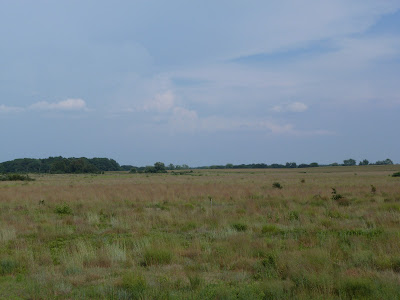Our summer began with periodic excursions up and down the mighty Chester River looking for “soft” sediment that we hope to use for characterizing the chemistry of the bottom of Chester River. Why, you might ask? Well, many of the “chemicals of environmental concern”(COEC) are hydrophobic -which literally means afraid of water- but more appropriately reflects the sticky-particle bound nature of many of these contaminants. They don’t like to be dissolved in water, but like to bind to the surfaces of particles and, ultimately, the sediment. Our interest in COECs is directed towards a better understanding of how these chemicals are introduced into the aquatic environment, how they affect resident organisms, and where they may ultimately end up. Anyway, this communiqué is not about COECs but is more about the benthos – the critters that we found in or on the sediment during our summer of mucking about in boats.
Overall, we found very little living in the sediments we collected - or more appropriately, very little macro (large, non-microscopic) organisms. For those macro benthic organisms we did find we noted where, when, and what we found; either an occasional oyster, some mussels, and most often – when there was anything – the mighty Rangia.
This is blog is about the brackish clam,
Rangia cuneata (Fig.1); what their role may be in the Chester River ecosystem and whether they might be a good indicator of contaminant exposure and bio-accumulation (accumulation of chemicals in the tissues of the organism) in the Chester.
 |
| Fig. 1. Rangia collected from the Chester River about 2 miles south of Chestertown |
The Rangia clam, according to information provided by the Maryland Department of the Environment (MDE)1, is a brackish (low salinity) clam that is often found in waters with salinities between 5-15 parts per thousand (fresh water is 0 ppt, ocean water at the mouth of the Chesapeake is ~32 ppt). They often live in highly turbid waters (water that contains a lot of suspended particles, muddy), often preferring soft substrates; usually a sand/mud mixture with vegetation detritus. They are subtidal suspensivores (they filter material out of the water column for food) and are also considered saprophytic, that is they also derive nourishment from dead or decaying organic matter (much like bacteria or fungi). The species found in the Chesapeake are
Rangia cuneata and, to this date, the Chesapeake is the northern most reach of their distribution. Apparently, they weren’t always a part of the Chesapeake ecosystem. In fact (according to MDE), the first known sighting of
R. cuneata was in 1960 in the Potomac River and are now found in the brackish tributaries and creeks of the upper Chesapeake Bay. Does the timing of their occurrence correspond to increases turbidity in the Chesapeake? Definitely an interesting question….
As a food source for humans, they are considered non-desirable, often because they have an earthy, muddy taste. Investigators from NOAA2 report a very active fishery for Rangia along the east coast of Mexico where they are used as a supplement to local shellfish and fish cuisine, often because they present a less desirable pallet when served alone. In Figure 2, we show where we have found Rangia this summer. The sites where we collected sediment are indicated by black triangles and where we found Rangia clams are shown by the red circles. One hope is that these organisms can help filter and clean the highly turbid waters of the Chester or the even the lower salinity realms of the Bay . Some investigators3 show that Rangia is a good indicator of a system under significant stress; that they represent a situation where other organisms struggle to survive and the ecosystem is in poor health. Rangia are also being investigated as a potential contaminant cleaner-upper for the impact of the BP oil release in the Gulf of Mexico4 Figure 2. Surface sediment grabs sites (black triangles) from the Chester River, summer 2012. The red dots overlay stations where we found Rangia clams.
 |
Fig. 2.
Surface sediment
grabs sites (black triangles) from the Chester River, summer 2012.
The red dots overlay stations where we found Rangia clams
|
One of our interests at the Center for the Environment and Society is whether Rangia can serve as biological indicator for contaminant exposure in the Chester River ecosystem. Do contaminants like lead, copper, arsenic and other COEC accumulate in Chester River resident organisms? Is Rangia a potential pathway for the transfer COEC to “higher” organisms that reside in the Chester River ecosystem (e.g., white perch, osprey, humans,etc) where COEC may become further concentrated as they move up the food chain? We don’t know, but we will be measuring the content of some of the COEC in their soft tissues using the relatively new high tech inductively-coupled
Mass Spectrometer at Washington College. Stay tuned!
 |
| Samuel Hartman, a summer Hodson Fellow, looks to find the optimal site for our next sediment grab |
Christian Krahforst is the Mellon Post Doctoral Fellow of Biogeochemistry for the
Center for Environment & Society at Washington College.



















+wing+molt+07-23-07.jpg)

